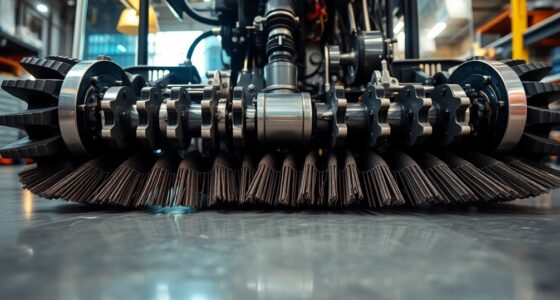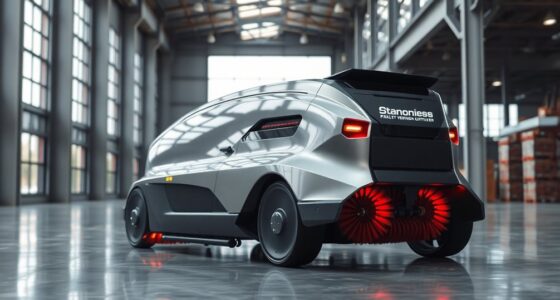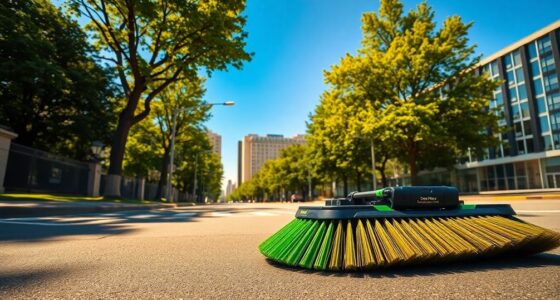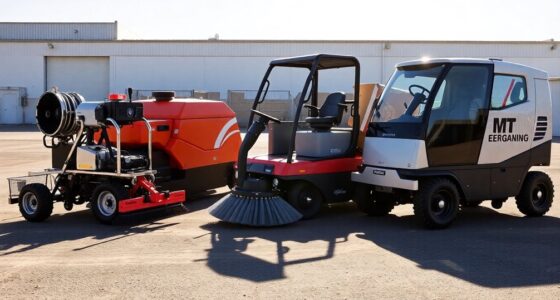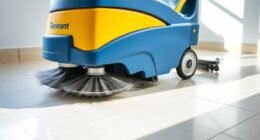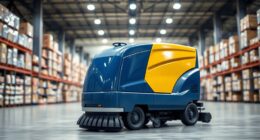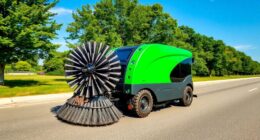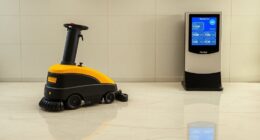The evolution of industrial sweeper machines started with manual cleaning processes, which relied heavily on human labor. With the introduction of electric-powered machines in the 1920s and advancements like the 1980s Trilobite robotic vacuum, cleaning became more efficient and less labor-intensive. Today's automated systems feature AI and smart technology for real-time adjustments, ensuring thorough cleaning without much human intervention. There's plenty more to discover about the innovations shaping modern cleaning practices.
Key Takeaways
- Industrial cleaning began with manual methods, evolving in the late 19th century with the introduction of hand-cranked carpet sweepers.
- Electric-powered sweepers emerged in the early 20th century, significantly reducing manual labor and improving cleaning efficiency.
- The 1950s saw the development of electric floor scrubbers, enhancing the cleaning capabilities for larger commercial spaces.
- The introduction of robotic vacuums in the 1980s marked the beginning of automated cleaning systems, leading to advanced AI-integrated models today.
- COVID-19 heightened the focus on hygiene, driving innovations in autonomous cleaning machines with disinfection technologies and enhanced filtration systems.
The Dawn of Mechanical Cleaning
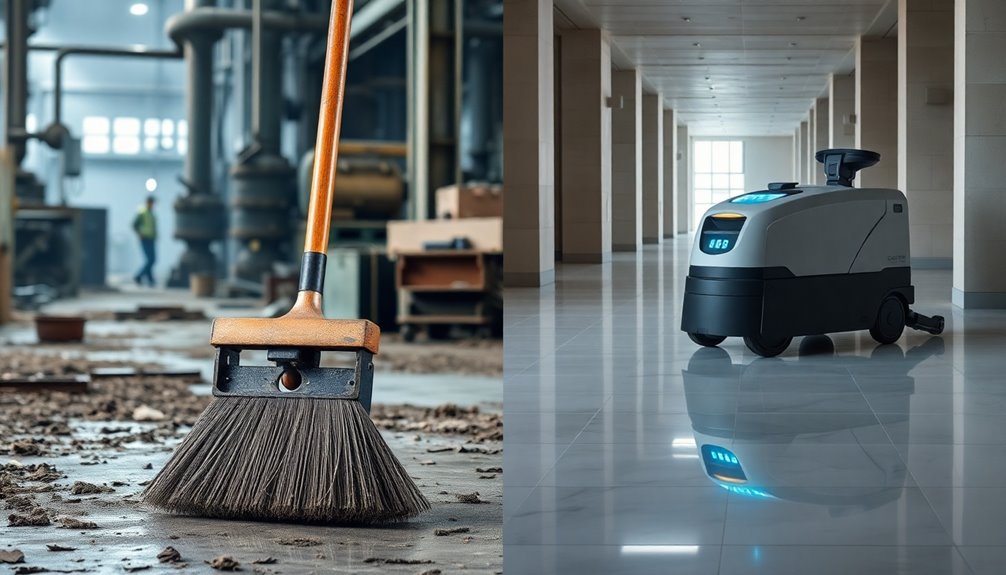
As mechanical cleaning began to emerge in the late 19th century, it revolutionized how we tackle dirt and debris. The introduction of basic cleaning machines, like Ives W. McGaffey's hand-cranked carpet sweeper, marked a significant shift.
You'd notice how much easier it became to reduce manual labor while cleaning floors. These innovations paved the way for early electric-powered sweepers in the early 20th century, which incorporated electric motors to boost performance and convenience.
With these advancements, you could clean larger areas more effectively, enhancing cleaning standards across various industries. The groundwork laid by these early machines eventually led to the development of sophisticated automated systems, which now dominate the cleaning landscape, making your cleaning tasks quicker and more efficient than ever before.
The Rise of Electric Power in Cleaning
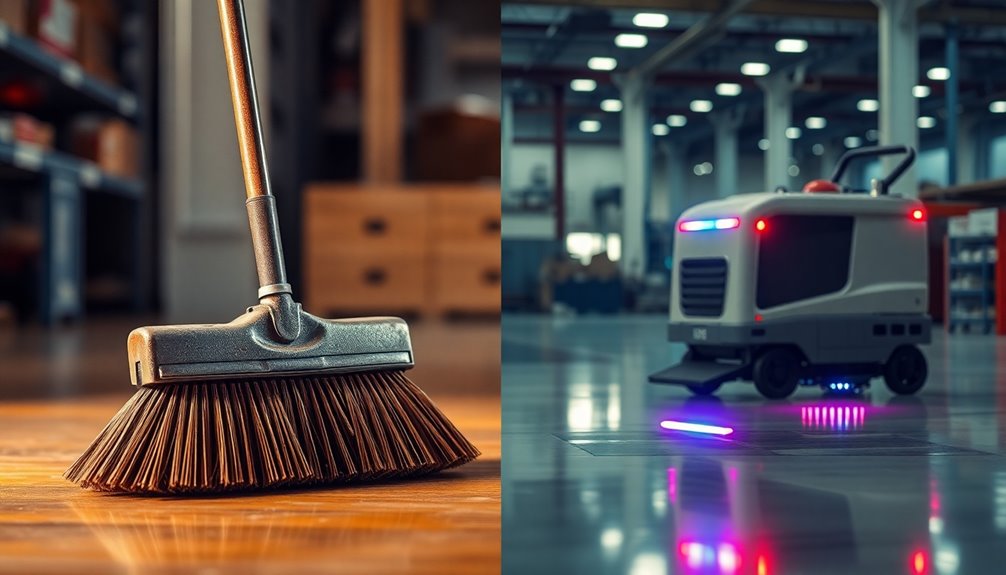
The introduction of electric power transformed the cleaning industry, making tasks faster and more efficient.
With the arrival of electric vacuum cleaners in the 1920s, you saw a significant reduction in manual labor and a boost in hygiene standards across various sectors.
By the 1950s, electric floor scrubbers emerged, utilizing rotating brushes and electric motors to enhance cleaning efficiency.
This shift to electric-powered equipment allowed you to clean larger spaces in a fraction of the time compared to traditional methods.
Modern electric floor care machines now feature onboard cleaning solution dispensing systems and adjustable brush pressure, further improving operational convenience and effectiveness.
Embracing these advancements in automated cleaning has set new standards for cleanliness and productivity in industrial settings. Additionally, the use of air quality improvement technologies in industrial spaces can enhance the overall working environment, promoting better health for employees.
Innovative Steam Cleaning Technologies

When you consider the advantages of high-pressure steam, you'll find it's a powerful ally in industrial cleaning.
It penetrates dirt and grime effectively, making it versatile for various applications across industries.
Plus, its ability to sanitize without harsh chemicals makes it a smart choice for maintaining hygiene standards.
High-Pressure Steam Advantages
While many traditional cleaning methods struggle with stubborn grime, high-pressure steam cleaning offers a powerful solution that not only eliminates dirt but also kills up to 99.9% of bacteria and viruses.
This method utilizes steam at temperatures exceeding 200°F, ensuring efficient cleaning in industrial settings. By reducing the reliance on harsh chemicals, it promotes eco-friendly cleaning practices, minimizing chemical exposure for users and the environment.
High-pressure steam penetrates porous surfaces and crevices, ensuring thorough cleaning of equipment and floors that other methods might miss. Plus, it notably cuts down labor costs and time, often requiring less scrubbing and fewer passes.
Modern steam cleaning machines allow you to adjust pressure and temperature, making them versatile for various surfaces.
Versatile Industrial Applications
High-pressure steam cleaning isn't just about tackling tough grime; it also opens the door to a range of versatile industrial applications.
With innovative steam cleaning technologies, you can achieve efficient, automated cleaning solutions that guarantee hygienic results without harsh chemicals.
Here are three key benefits:
- Sanitization: Operates above 200°F to eliminate bacteria and viruses, essential in food production and healthcare.
- Material Compatibility: Works on various surfaces like tile, concrete, and machinery, making it ideal for diverse environments.
- Ergonomic Design: Reduces operator fatigue with lightweight construction and adjustable handles, enhancing overall efficiency.
The Emergence of Automated Cleaning Systems
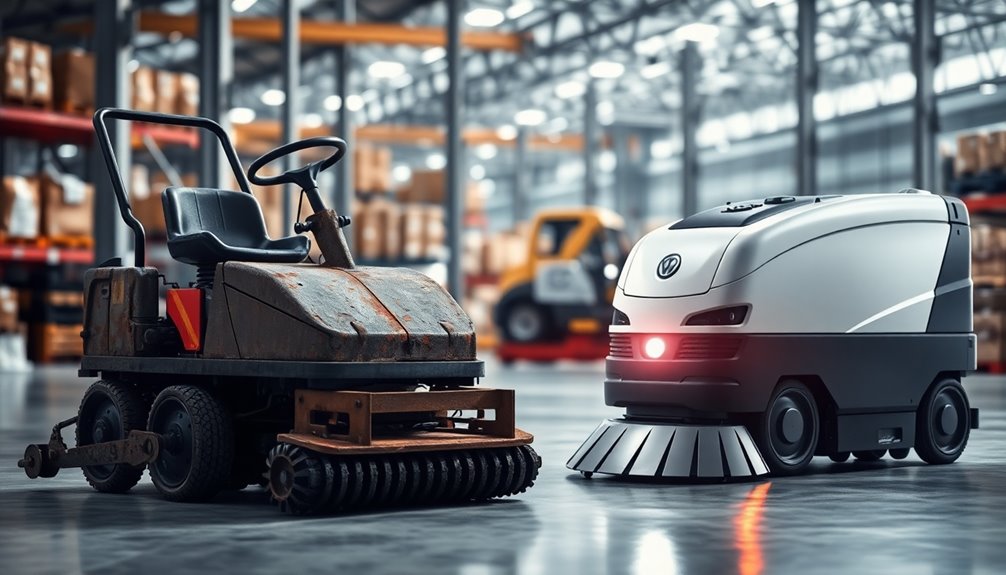
As the need for efficient cleaning solutions has grown, automated cleaning systems have emerged as a revolutionary force in the industry. These systems began evolving in the mid-20th century, with early floor scrubbers combining multiple functions to enhance cleaning efficiency. The introduction of the Trilobite in the 1980s, the first robotic vacuum, marked a significant leap in automated cleaning technology. Today, ride-on scrubbers and advanced models equipped with artificial intelligence and sensors can map spaces and adapt to various floor types. This evolution reflects a demand for improved productivity and cleanliness across commercial applications.
| Year | Innovation | Impact |
|---|---|---|
| 1950s | First multi-functional scrubbers | Enhanced cleaning efficiency |
| 1980s | Trilobite robotic vacuum | Pioneered autonomous cleaning |
| 2000s | Ride-on scrubbers | Improved coverage and productivity |
| 21st Century | AI and sensor-equipped systems | Adaptive cleaning capabilities |
| Future | Smart home integration | Seamless user experiences |
Advancements in Floor Scrubber Technology

Innovations in floor scrubber technology have transformed the way industries approach cleaning tasks, making them more efficient and user-friendly.
Here are three key advancements to evaluate:
- Smart Technology Integration: Modern scrubbers come equipped with onboard computers and IoT connectivity, allowing for real-time monitoring and adjustments.
- Improved Cleaning Performance: Features like adjustable brush pressure and onboard solution dispensing drastically enhance cleaning efficiency.
- Autonomous Cleaning Options: Recent models can operate autonomously, minimizing human intervention and maximizing productivity.
These advancements in floor scrubber technology not only elevate cleaning performance but also streamline operations in various environments, from warehouses to airports.
You'll find that investing in these machines pays off in both labor savings and cleaner facilities.
The Role of Robotics in Modern Cleaning
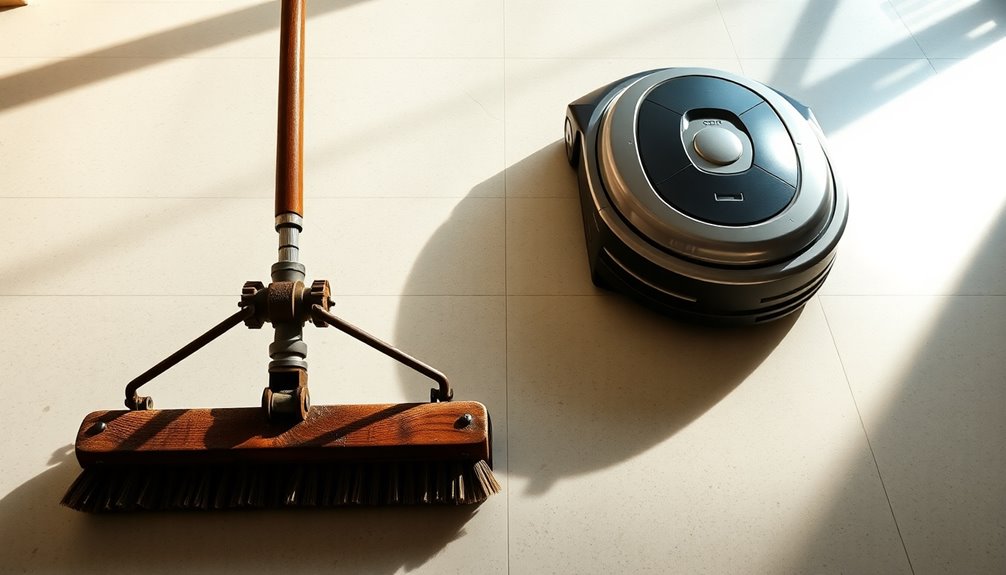
With the advancements in floor scrubber technology setting the stage for more efficient cleaning solutions, robotics has taken this evolution even further.
Robotic cleaning machines, like the autonomous floor scrubbers from companies such as Tennant, are revolutionizing industrial cleaning. These machines utilize advanced sensors and AI to navigate spaces independently, enhancing cleaning efficiency while reducing labor costs.
They can perform multiple tasks, including sweeping, scrubbing, and drying, making them versatile for large areas. Equipped with mapping capabilities, they create ideal cleaning routes and avoid obstacles.
The rise of automation in industrial cleaning meets the demand for high hygiene standards, especially in critical sectors like food production and healthcare, where maintaining cleanliness is essential for safety and compliance.
Sustainability and Safety in Floor Care Machines
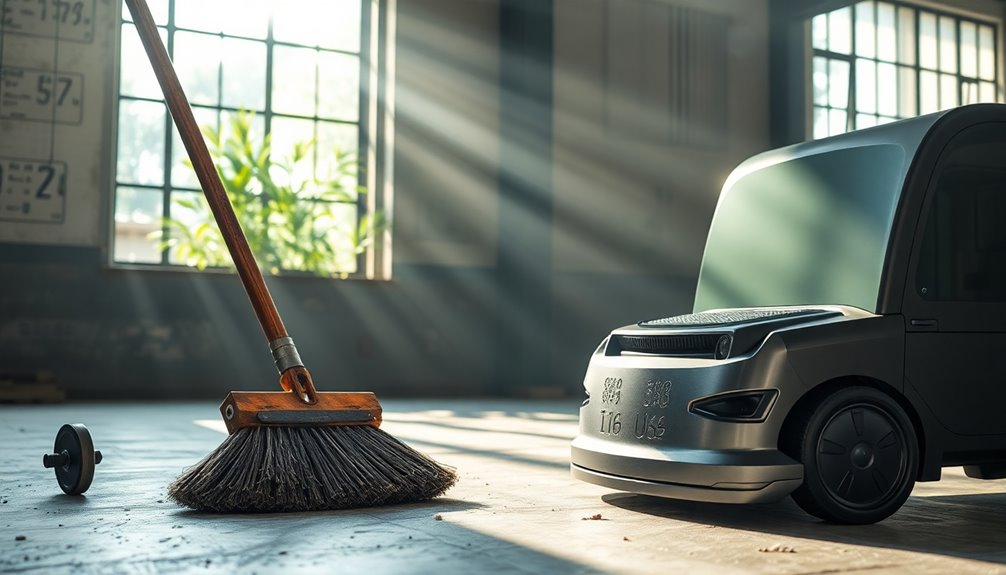
While the cleaning industry evolves, sustainability and safety have become paramount in the design of floor care machines.
You'll find that modern machines focus on:
- Eco-friendly materials: They utilize recyclable components, reducing environmental impact.
- Energy-efficient design: These machines lower carbon emissions and operational costs without sacrificing performance.
- Advanced safety features: Ergonomic designs and filtration systems enhance user comfort and improve indoor air quality.
Moreover, innovative technologies reduce water and chemical use, promoting sustainable practices.
Noise reduction features also guarantee quieter operations, minimizing disruption in your environment.
The Impact of COVID-19 on Cleaning Innovations
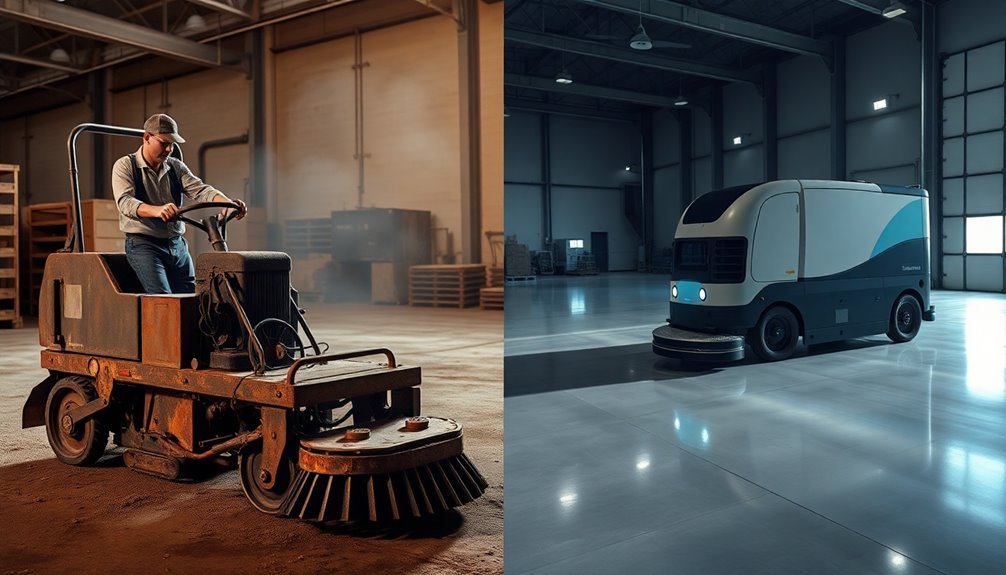
The COVID-19 pandemic pushed hygiene standards to new heights, and you likely noticed a surge in demand for efficient sanitization solutions.
As public spaces prioritized cleanliness, innovations in industrial sweeper machines emerged to meet these heightened expectations.
Now, automated systems with advanced sanitizing capabilities are essential for maintaining a safe environment.
Hygiene Standards Enhancement
As hygiene standards soared during the COVID-19 pandemic, industries quickly adapted to meet the new demands for cleanliness and safety.
You've likely noticed a surge in innovations aimed at efficient cleaning solutions, including:
- Advanced sanitizing capabilities, such as UV technology designed to eliminate harmful pathogens.
- The rise of non-toxic cleaning solutions prioritizing safety while maintaining effectiveness.
- Improved filtration systems that capture allergens and enhance indoor air quality.
These advancements have reshaped cleaning procedures, prompting organizations to adopt regular cleaning schedules and utilize automated machines.
With a focus on sanitization and disinfection, achieving compliance with heightened hygiene standards has never been more critical. Additionally, the implementation of performance cookies has enabled businesses to track the effectiveness of their cleaning practices and optimize their strategies accordingly.
This evolution not only protects your health but also creates safer environments for everyone.
Demand for Sanitization Solutions
With the onset of the COVID-19 pandemic, a significant shift occurred in how industries approach cleanliness. You likely noticed the heightened demand for sanitization solutions in public spaces, which led to a surge in industrial cleaning machines featuring advanced disinfection technologies.
Enhanced hygiene standards pushed manufacturers to develop floor care machines that integrate sanitizing capabilities, like UV technology, to effectively eliminate harmful pathogens. As cleaning demands grew, automatic floor scrubbers emerged with improved filtration systems, enhancing indoor air quality while capturing allergens.
Additionally, the focus on non-toxic cleaning solutions guaranteed safer environments. Innovations in fully autonomous cleaning machines, equipped with sensors and AI, now allow for efficient, independent operation in diverse settings, meeting the urgent need for effective sanitization. This evolution mirrors the growing emphasis on energy efficiency ratings, which guide users in optimizing their cleaning operations.
Frequently Asked Questions
How Do Industrial Sweepers Differ From Regular Vacuum Cleaners?
Industrial sweepers differ from regular vacuum cleaners primarily in their size and functionality.
While you'd use a vacuum for home cleaning, industrial sweepers are designed for large areas like warehouses or parking lots. They can handle heavier debris and often feature larger tanks for collecting dirt.
Plus, sweepers usually operate on a powered system, allowing you to clean efficiently without the manual effort required by traditional vacuums.
You'll notice a significant difference in performance!
What Maintenance Is Required for Industrial Sweeper Machines?
To keep your industrial sweeper machines running efficiently, regular maintenance is essential.
You'll need to check and replace filters, clean the brushes, and inspect belts for wear.
Be certain to lubricate moving parts and monitor battery levels if your machine is powered by batteries.
It's also a good idea to schedule periodic professional servicing to catch any issues early.
Following these steps guarantees your sweeper performs at its best for longer.
Can Industrial Sweepers Be Used Outdoors?
Yes, you can definitely use industrial sweepers outdoors.
They're designed to handle various terrains and conditions, making them ideal for cleaning parking lots, sidewalks, and other outdoor spaces.
Just make certain the sweeper you choose is suitable for outdoor use, as some models excel on rough surfaces while others are better for smoother areas.
Regularly check the machine's components to guarantee peak performance in outdoor environments, especially after heavy use.
What Safety Features Are Included in Modern Sweepers?
As the saying goes, "Better safe than sorry."
Modern sweepers come equipped with numerous safety features to protect operators and pedestrians. You'll find systems like obstacle detection sensors, emergency stop buttons, and automatic shut-off functions.
Many models also include bright LED lights for visibility and warning signals to alert nearby individuals.
These enhancements guarantee not only efficient cleaning but a safer environment for everyone involved, making your job easier and more secure.
How Do Automated Sweepers Handle Obstacles in Their Path?
Automated sweepers use advanced sensors and cameras to detect obstacles in their path.
When they encounter an object, they quickly analyze the situation and decide whether to navigate around it or stop.
You'll often see them adjust their route in real-time, ensuring efficient cleaning without damaging the machine or the surroundings.
With their smart technology, these sweepers minimize interruptions and maintain a consistent cleaning performance, making your job easier and more effective.
Conclusion
From the toil of manual sweeping to the precision of automated cleaning, you can see how far we've come. While early machines struggled with basic tasks, today's innovations tackle complex challenges effortlessly. As robotics revolutionize the industry, you're left with a cleaner environment and reduced labor demands. Yet, amidst this technological leap, the emphasis on sustainability and safety remains essential. In a world reshaped by COVID-19, the evolution of these machines isn't just about efficiency—it's about a healthier future.


